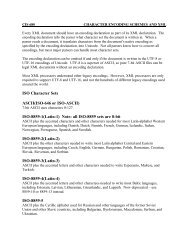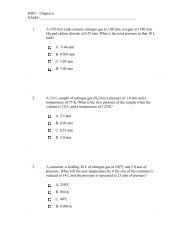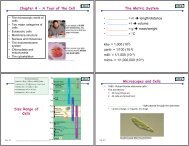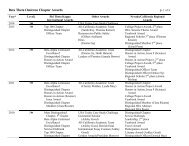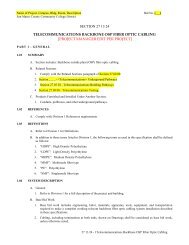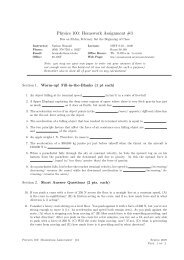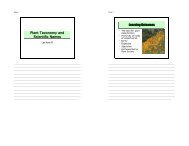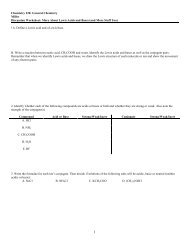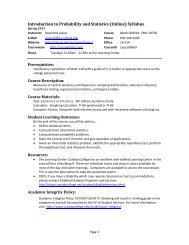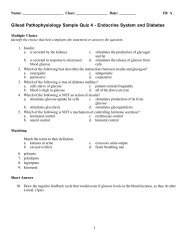A Brief History of Microbiology Learning Outcomes
A Brief History of Microbiology Learning Outcomes
A Brief History of Microbiology Learning Outcomes
Create successful ePaper yourself
Turn your PDF publications into a flip-book with our unique Google optimized e-Paper software.
Slide 1<br />
Slide 2<br />
<strong>Learning</strong> <strong>Outcomes</strong><br />
A <strong>Brief</strong> <strong>History</strong> <strong>of</strong> <strong>Microbiology</strong><br />
Lecture 2<br />
• Classification <strong>of</strong> microorganisms<br />
• A <strong>Brief</strong> <strong>History</strong> <strong>of</strong> <strong>Microbiology</strong><br />
• Spontaneous generation<br />
• Germ Theory <strong>of</strong> Disease<br />
• Applications <strong>of</strong> microbes<br />
• Infectious Diseases<br />
Biol 240 S06 2<br />
________________________________________________________________________<br />
________________________________________________________________________<br />
________________________________________________________________________<br />
________________________________________________________________________<br />
________________________________________________________________________<br />
________________________________________________________________________<br />
________________________________________________________________________<br />
________________________________________________________________________<br />
________________________________________________________________________<br />
________________________________________________________________________<br />
________________________________________________________________________<br />
____________________________________________________________________<br />
________________________________________________________________________<br />
________________________________________________________________________<br />
________________________________________________________________________<br />
________________________________________________________________________<br />
________________________________________________________________________<br />
________________________________________________________________________<br />
________________________________________________________________________<br />
________________________________________________________________________<br />
________________________________________________________________________<br />
________________________________________________________________________<br />
________________________________________________________________________<br />
____________________________________________________________________
Slide 3<br />
Slide 4<br />
Microorganisms<br />
How to Use Study Questions<br />
• Organisms too small to be seen with the<br />
unaided eye.<br />
• “Germ”<br />
– unscientific commonly used by media<br />
– Any disease causing microorganism<br />
• Microbes<br />
– All Bacteria, Archaea, Protists, Viruses<br />
– also some fungi, some animals (helminths),<br />
Biol 240 S06 3<br />
• What makes sourdough sour? What<br />
is name the organism that is<br />
responsible for making sourdough<br />
sour. Which type <strong>of</strong> microbe is it?<br />
Which metabolic process is<br />
responsible for the sour taste and<br />
what chemical end product is<br />
detected by the taste buds as<br />
‘sour’?<br />
Biol 240 S06 4<br />
________________________________________________________________________<br />
________________________________________________________________________<br />
________________________________________________________________________<br />
________________________________________________________________________<br />
________________________________________________________________________<br />
________________________________________________________________________<br />
________________________________________________________________________<br />
________________________________________________________________________<br />
________________________________________________________________________<br />
________________________________________________________________________<br />
________________________________________________________________________<br />
____________________________________________________________________<br />
________________________________________________________________________<br />
________________________________________________________________________<br />
________________________________________________________________________<br />
________________________________________________________________________<br />
________________________________________________________________________<br />
________________________________________________________________________<br />
________________________________________________________________________<br />
________________________________________________________________________<br />
________________________________________________________________________<br />
________________________________________________________________________<br />
________________________________________________________________________<br />
____________________________________________________________________
Slide 5<br />
Slide 6<br />
“Excuse me Waiter, the Bread tastes<br />
Funny”<br />
• Unique to San Francisco<br />
• Yeast ferments sugar to CO 2<br />
• The bacterium (1 point)<br />
Lactobacillus sanfranciscensis<br />
(2 points)<br />
• Ferments (1 point) sugars to<br />
lactic acid (1 point)<br />
•<br />
Biol 240 S06 5<br />
• Pre Carl Woese<br />
– life was classified into 5<br />
Kingdoms based on<br />
observable differences<br />
(macroscopic)<br />
– Plants, Fungi, Animals,<br />
Protista, and Monera<br />
(bacteria)<br />
• 1978 Woese created 3<br />
‘Domain’ System based<br />
upon fundamental<br />
differences between cells<br />
• Cell wall and plasma<br />
membrane structure and<br />
rRNA sequences<br />
– Bacteria<br />
– Archaea<br />
– Eukarya<br />
Diversity <strong>of</strong> Life<br />
Biol 240 S06 6<br />
________________________________________________________________________<br />
________________________________________________________________________<br />
________________________________________________________________________<br />
________________________________________________________________________<br />
________________________________________________________________________<br />
________________________________________________________________________<br />
________________________________________________________________________<br />
________________________________________________________________________<br />
________________________________________________________________________<br />
________________________________________________________________________<br />
________________________________________________________________________<br />
____________________________________________________________________<br />
________________________________________________________________________<br />
________________________________________________________________________<br />
________________________________________________________________________<br />
________________________________________________________________________<br />
________________________________________________________________________<br />
________________________________________________________________________<br />
________________________________________________________________________<br />
________________________________________________________________________<br />
________________________________________________________________________<br />
________________________________________________________________________<br />
________________________________________________________________________<br />
____________________________________________________________________
Slide 7<br />
Slide 8<br />
• Prokaryotes<br />
• No nucleus<br />
• Bacteria<br />
– Peptidoglycan cell wall<br />
• Archaea<br />
– Cell walls NOT peptidoglycan<br />
• Eukaryotes<br />
• All have nuclei<br />
• Fungi<br />
– Cell wall chitin<br />
• Algae<br />
– Cell wall cellulose; photosynthetic<br />
• Protozoa<br />
– Unicellular; lack cell wall<br />
• Helminths<br />
– Multicellular animals<br />
Diversity <strong>of</strong> Life<br />
• Viruses are NOT classified<br />
as organisms<br />
• NOT composed <strong>of</strong> cells<br />
• NO independent metabolism<br />
• Incapable <strong>of</strong> growth or<br />
reproduction on their own<br />
• BUT do possess genes<br />
(either RNA or DNA) and<br />
evolve (rapidly) by Natural<br />
Selection<br />
• Influenza virus mutates so<br />
that an ‘annual flu shot’ is<br />
required<br />
Viruses<br />
Reconstructed 1918<br />
H 1 N 1 influenza virus<br />
Biol 240 S06 7<br />
Biol 240 S06 8<br />
________________________________________________________________________<br />
________________________________________________________________________<br />
________________________________________________________________________<br />
________________________________________________________________________<br />
________________________________________________________________________<br />
________________________________________________________________________<br />
________________________________________________________________________<br />
________________________________________________________________________<br />
________________________________________________________________________<br />
________________________________________________________________________<br />
________________________________________________________________________<br />
____________________________________________________________________<br />
________________________________________________________________________<br />
________________________________________________________________________<br />
________________________________________________________________________<br />
________________________________________________________________________<br />
________________________________________________________________________<br />
________________________________________________________________________<br />
________________________________________________________________________<br />
________________________________________________________________________<br />
________________________________________________________________________<br />
________________________________________________________________________<br />
________________________________________________________________________<br />
____________________________________________________________________
Slide 9<br />
Slide 10<br />
Purpose <strong>of</strong> Classification<br />
• Grouping organisms into meaningful<br />
categories based upon characteristics<br />
• Unambiguity in communication<br />
• Why Latin?<br />
• Notation<br />
• Bacillus anthracis<br />
• Robert Hooke 1665<br />
– Observed ‘cells’ in cork<br />
Cell Theory<br />
• Schleiden, Schwann (1839)<br />
– All living organisms are composed <strong>of</strong> cells<br />
– Cells are the basic unit <strong>of</strong> structure and function <strong>of</strong> life<br />
• Virchow, (1855)<br />
– All cells come from preexisting cells<br />
Biol 240 S06 9<br />
• Cell Theory Timeline<br />
• http://www.timeline-help.com/the-cell-theorytimeline.html<br />
Biol 240 S06 10<br />
________________________________________________________________________<br />
________________________________________________________________________<br />
________________________________________________________________________<br />
________________________________________________________________________<br />
________________________________________________________________________<br />
________________________________________________________________________<br />
________________________________________________________________________<br />
________________________________________________________________________<br />
________________________________________________________________________<br />
________________________________________________________________________<br />
________________________________________________________________________<br />
____________________________________________________________________<br />
________________________________________________________________________<br />
________________________________________________________________________<br />
________________________________________________________________________<br />
________________________________________________________________________<br />
________________________________________________________________________<br />
________________________________________________________________________<br />
________________________________________________________________________<br />
________________________________________________________________________<br />
________________________________________________________________________<br />
________________________________________________________________________<br />
________________________________________________________________________<br />
____________________________________________________________________
Slide 11<br />
Slide 12<br />
• 1673-1723<br />
• First observation<br />
– Bacteria<br />
– protists<br />
• One lens<br />
• 200x<br />
magnification<br />
• compound 2<br />
lenses<br />
Anthony Van<br />
Leeuwenhoek<br />
Spontaneous Generation Controversy<br />
• 150 years ago<br />
believed that<br />
microorganisms<br />
sprang from food<br />
• Life from non-Life<br />
• Also toads ‘born’<br />
from moist soil<br />
Biol 240 S06 11<br />
Biol 240 S06 12<br />
________________________________________________________________________<br />
________________________________________________________________________<br />
________________________________________________________________________<br />
________________________________________________________________________<br />
________________________________________________________________________<br />
________________________________________________________________________<br />
________________________________________________________________________<br />
________________________________________________________________________<br />
________________________________________________________________________<br />
________________________________________________________________________<br />
________________________________________________________________________<br />
____________________________________________________________________<br />
________________________________________________________________________<br />
________________________________________________________________________<br />
________________________________________________________________________<br />
________________________________________________________________________<br />
________________________________________________________________________<br />
________________________________________________________________________<br />
________________________________________________________________________<br />
________________________________________________________________________<br />
________________________________________________________________________<br />
________________________________________________________________________<br />
________________________________________________________________________<br />
____________________________________________________________________
Slide 13<br />
Slide 14<br />
Francesco Redi<br />
John Needham<br />
• 1668: filled six jars with decaying meat.<br />
Conditions<br />
3 jars covered with<br />
fine net<br />
3 open jars<br />
Results<br />
No maggots<br />
Maggots appeared<br />
From where did the maggots come?<br />
What was the purpose <strong>of</strong> the sealed jars?<br />
Spontaneous generation or biogenesis?<br />
Biol 240 S06 13<br />
• 1745: put boiled nutrient broth into<br />
covered flasks.<br />
Conditions<br />
Results<br />
Nutrient broth Microbial growth<br />
heated, then placed in<br />
sealed flask<br />
From where did the microbes come?<br />
Spontaneous generation or biogenesis?<br />
Biol 240 S06 14<br />
________________________________________________________________________<br />
________________________________________________________________________<br />
________________________________________________________________________<br />
________________________________________________________________________<br />
________________________________________________________________________<br />
________________________________________________________________________<br />
________________________________________________________________________<br />
________________________________________________________________________<br />
________________________________________________________________________<br />
________________________________________________________________________<br />
________________________________________________________________________<br />
____________________________________________________________________<br />
________________________________________________________________________<br />
________________________________________________________________________<br />
________________________________________________________________________<br />
________________________________________________________________________<br />
________________________________________________________________________<br />
________________________________________________________________________<br />
________________________________________________________________________<br />
________________________________________________________________________<br />
________________________________________________________________________<br />
________________________________________________________________________<br />
________________________________________________________________________<br />
____________________________________________________________________
Slide 15<br />
Slide 16<br />
Lazarro Spallanzani<br />
• 1765: Claimed Needhams microbes already<br />
present in flasks (non-sterile)<br />
• put nutrient broth into covered flasks<br />
then boiled.<br />
Conditions<br />
Results<br />
Nutrient broth placed No microbial growth<br />
in sealed flask then<br />
heated.<br />
Cell Theory Timeline:<br />
http://www.timeline-help.com/the-cell-theorytimeline.html<br />
Biol 240 S06 15<br />
The Theory <strong>of</strong> Biogenesis<br />
• 1858: Pasteur’s S-shaped flask kept<br />
microbes out but let air in.<br />
• Biogenesis life can only come from life<br />
Biol 240 S06 16<br />
Figure 1.3<br />
________________________________________________________________________<br />
________________________________________________________________________<br />
________________________________________________________________________<br />
________________________________________________________________________<br />
________________________________________________________________________<br />
________________________________________________________________________<br />
________________________________________________________________________<br />
________________________________________________________________________<br />
________________________________________________________________________<br />
________________________________________________________________________<br />
________________________________________________________________________<br />
____________________________________________________________________<br />
________________________________________________________________________<br />
________________________________________________________________________<br />
________________________________________________________________________<br />
________________________________________________________________________<br />
________________________________________________________________________<br />
________________________________________________________________________<br />
________________________________________________________________________<br />
________________________________________________________________________<br />
________________________________________________________________________<br />
________________________________________________________________________<br />
________________________________________________________________________<br />
____________________________________________________________________
Slide 17<br />
Slide 18<br />
Germ Theory <strong>of</strong> Disease<br />
Robert Koch<br />
• Disease linked with<br />
superstition and<br />
witchcraft<br />
• Miasma<br />
• “mal aria” in Rome<br />
ascribed to<br />
poisonous gasses in<br />
swamps<br />
• 1876<br />
• Discovered<br />
anthrax<br />
causing<br />
bacterium<br />
• Koch’s<br />
Postulates<br />
Biol 240 S06 17<br />
Biol 240 S06 18<br />
________________________________________________________________________<br />
________________________________________________________________________<br />
________________________________________________________________________<br />
________________________________________________________________________<br />
________________________________________________________________________<br />
________________________________________________________________________<br />
________________________________________________________________________<br />
________________________________________________________________________<br />
________________________________________________________________________<br />
________________________________________________________________________<br />
________________________________________________________________________<br />
____________________________________________________________________<br />
________________________________________________________________________<br />
________________________________________________________________________<br />
________________________________________________________________________<br />
________________________________________________________________________<br />
________________________________________________________________________<br />
________________________________________________________________________<br />
________________________________________________________________________<br />
________________________________________________________________________<br />
________________________________________________________________________<br />
________________________________________________________________________<br />
________________________________________________________________________<br />
____________________________________________________________________
Slide 19<br />
Slide 20<br />
Koch’s Postulates<br />
• The same pathogen must be<br />
present in every case <strong>of</strong> the<br />
disease<br />
• The pathogen must be isolated<br />
from the diseased host and<br />
grown in pure culture<br />
• The pathogen from the pure<br />
culture must cause the disease<br />
when it is inoculated into a<br />
healthy, susceptible animal<br />
• The pathogen must be isolated<br />
from the inoculated animal and<br />
must be shown to be the<br />
original organism<br />
Biol 240 S06 19<br />
• Observed mortality<br />
rate <strong>of</strong> mothers<br />
higher when attended<br />
by doctors<br />
• puerperal fever<br />
• Hypothesis: docs<br />
transmitting disease<br />
on unwashed hands<br />
Semmelweis<br />
Biol 240 S06 20<br />
________________________________________________________________________<br />
________________________________________________________________________<br />
________________________________________________________________________<br />
________________________________________________________________________<br />
________________________________________________________________________<br />
________________________________________________________________________<br />
________________________________________________________________________<br />
________________________________________________________________________<br />
________________________________________________________________________<br />
________________________________________________________________________<br />
________________________________________________________________________<br />
____________________________________________________________________<br />
________________________________________________________________________<br />
________________________________________________________________________<br />
________________________________________________________________________<br />
________________________________________________________________________<br />
________________________________________________________________________<br />
________________________________________________________________________<br />
________________________________________________________________________<br />
________________________________________________________________________<br />
________________________________________________________________________<br />
________________________________________________________________________<br />
________________________________________________________________________<br />
____________________________________________________________________
Slide 21<br />
Slide 22<br />
• Mortality due to<br />
puerperal fever<br />
(Streptococcus<br />
pyogenes) 18% May<br />
1847<br />
• Semmelweis<br />
initiated handwashing<br />
regime with<br />
chlorinated lime<br />
(CaClO 2 )<br />
• Mortality fell to less<br />
than 3% in June–<br />
November 1847<br />
Semmelweis<br />
Joseph Lister<br />
Lister<br />
pw1.netcom.com/~aguldo/ agga/bt/txt/bt1899.htm<br />
Biol 240 S06 21<br />
www.umanitoba.ca/.../medicine/ history/lister/anessurg.html<br />
Biol 240 S06 22<br />
________________________________________________________________________<br />
________________________________________________________________________<br />
________________________________________________________________________<br />
________________________________________________________________________<br />
________________________________________________________________________<br />
________________________________________________________________________<br />
________________________________________________________________________<br />
________________________________________________________________________<br />
________________________________________________________________________<br />
________________________________________________________________________<br />
________________________________________________________________________<br />
____________________________________________________________________<br />
________________________________________________________________________<br />
________________________________________________________________________<br />
________________________________________________________________________<br />
________________________________________________________________________<br />
________________________________________________________________________<br />
________________________________________________________________________<br />
________________________________________________________________________<br />
________________________________________________________________________<br />
________________________________________________________________________<br />
________________________________________________________________________<br />
________________________________________________________________________<br />
____________________________________________________________________
Slide 23<br />
Slide 24<br />
Edward Jenner<br />
• 1796<br />
• Observed prevalence <strong>of</strong><br />
smallpox lower in rural<br />
than urban areas<br />
• Milkmaid with cow pox<br />
blisters didn’t develop<br />
smallpox<br />
• Scratched pus from<br />
cowpox blister into arm<br />
<strong>of</strong> ‘volunteer’<br />
• Exposed volunteer to<br />
smallpox to prove<br />
immunity<br />
• Vacca = cow<br />
• Vaccination<br />
Alexander<br />
Fleming<br />
• 1928: Culture plates <strong>of</strong><br />
Staphylococcus aureus<br />
“contaminated” by mold<br />
• Noticed halo <strong>of</strong><br />
inhibition <strong>of</strong> bacterial<br />
growth<br />
• Mold Penicillium<br />
notatum<br />
• Inhibition due to<br />
Penicillin<br />
Biol 240 S06 23<br />
Biol 240 S06 24<br />
________________________________________________________________________<br />
________________________________________________________________________<br />
________________________________________________________________________<br />
________________________________________________________________________<br />
________________________________________________________________________<br />
________________________________________________________________________<br />
________________________________________________________________________<br />
________________________________________________________________________<br />
________________________________________________________________________<br />
________________________________________________________________________<br />
________________________________________________________________________<br />
____________________________________________________________________<br />
________________________________________________________________________<br />
________________________________________________________________________<br />
________________________________________________________________________<br />
________________________________________________________________________<br />
________________________________________________________________________<br />
________________________________________________________________________<br />
________________________________________________________________________<br />
________________________________________________________________________<br />
________________________________________________________________________<br />
________________________________________________________________________<br />
________________________________________________________________________<br />
____________________________________________________________________



